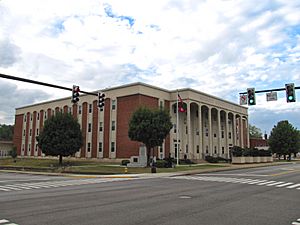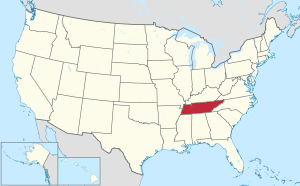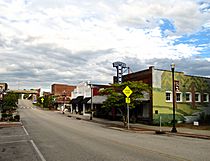Anderson County, Tennessee facts for kids
Quick facts for kids
Anderson County
|
||
|---|---|---|

Anderson County Courthouse in Clinton
|
||
|
||

Location within the U.S. state of Tennessee
|
||
 Tennessee's location within the U.S. |
||
| Country | ||
| State | ||
| Founded | November 6, 1801 | |
| Named for | Joseph Anderson | |
| Seat | Clinton | |
| Largest city | Oak Ridge | |
| Area | ||
| • Total | 345 sq mi (890 km2) | |
| • Land | 337 sq mi (870 km2) | |
| • Water | 7.6 sq mi (20 km2) 2.2%% | |
| Population
(2020)
|
||
| • Total | 77,123 | |
| • Estimate
(2023)
|
80,234 |
|
| • Density | 223.5/sq mi (86.31/km2) | |
| Time zone | UTC−5 (Eastern) | |
| • Summer (DST) | UTC−4 (EDT) | |
| Congressional district | 3rd | |
Anderson County is a county in the state of Tennessee, USA. It is located in the northern part of East Tennessee. In 2020, about 77,123 people lived there. The main town and county seat is Clinton. Anderson County is part of the larger Knoxville, TN Metropolitan Statistical Area.
Contents
History of Anderson County
Before Anderson County was formed, this land belonged to the Eastern Band of Cherokee Indians. Some early families like the Wallaces and Gibbses settled here. In 1791, the Treaty of Holston was signed. It was meant to stop more settlers from moving into Cherokee lands. But many more people kept coming from Virginia and North Carolina.
This led to some small fights. Things became calmer after the Treaty of Tellico in 1798. This treaty allowed more settlers to move into the area.
Anderson County was created in 1801. It was made from parts of Grainger County, Tennessee and Knox County, Tennessee. Roane County, Tennessee, was also formed from Knox County in the same year. This is why they are sometimes called 'sister counties'.
The county was named after Joseph Anderson. He was a U.S. senator from Tennessee. He also served as a judge and a government money manager.
During the American Civil War, many people in Anderson County did not want to leave the United States. On June 8, 1861, they voted strongly against Tennessee joining the Confederacy.
Big changes came in the 1930s with the building of Norris Dam. This was the first dam built by the Tennessee Valley Authority (TVA). About 2,900 families had to move from their homes for the dam's lake. The town of Norris was built for the dam workers. After the dam was finished, the Clinch River below it became colder. This caused the pearl industry, which relied on mussels in the river, to disappear.
During World War II, the federal government started the Manhattan Project. This brought even more changes to the county. More families had to move, and the city of Oak Ridge was founded.
The Museum of Appalachia in Norris helps us remember how people lived long ago. It shows what pioneer and rural life was like in Anderson County.
Geography of Anderson County
The county covers about 345 square miles. Most of this (337 square miles) is land. About 7.6 square miles (2.2%) is water.
Neighboring Counties
- Campbell County (north)
- Union County (northeast)
- Knox County (southeast)
- Roane County (southwest)
- Morgan County (west)
- Scott County (northwest)
Protected Areas
- Manhattan Project National Historical Park (part)
- Norris Dam State Park (part)
- North Cumberland Wildlife Management Area (part)
Population Information
| Historical population | |||
|---|---|---|---|
| Census | Pop. | %± | |
| 1810 | 3,959 | — | |
| 1820 | 4,668 | 17.9% | |
| 1830 | 5,310 | 13.8% | |
| 1840 | 5,658 | 6.6% | |
| 1850 | 6,938 | 22.6% | |
| 1860 | 7,068 | 1.9% | |
| 1870 | 8,704 | 23.1% | |
| 1880 | 10,820 | 24.3% | |
| 1890 | 15,128 | 39.8% | |
| 1900 | 17,634 | 16.6% | |
| 1910 | 17,717 | 0.5% | |
| 1920 | 18,298 | 3.3% | |
| 1930 | 19,722 | 7.8% | |
| 1940 | 26,504 | 34.4% | |
| 1950 | 59,407 | 124.1% | |
| 1960 | 60,032 | 1.1% | |
| 1970 | 60,300 | 0.4% | |
| 1980 | 67,346 | 11.7% | |
| 1990 | 68,250 | 1.3% | |
| 2000 | 71,330 | 4.5% | |
| 2010 | 75,129 | 5.3% | |
| 2020 | 77,123 | 2.7% | |
| 2023 (est.) | 80,234 | 6.8% | |
| U.S. Decennial Census 1790-1960 1900-1990 1990-2000 2010-2020 |
|||
2020 Census Details
| Race | Number | Percentage |
|---|---|---|
| White (not Hispanic) | 66,044 | 85.63% |
| Black or African American (not Hispanic) | 2,841 | 3.68% |
| Native American | 217 | 0.28% |
| Asian | 975 | 1.26% |
| Pacific Islander | 53 | 0.07% |
| Other/Mixed | 4,173 | 5.41% |
| Hispanic or Latino | 2,820 | 3.66% |
In 2020, there were 77,123 people living in Anderson County. There were 30,175 households and 19,074 families.
Economy of Anderson County
Anderson County has a strong tourism industry. Many people visit its attractions. These include Norris Lake, the Green McAdoo School, the Museum of Appalachia, and the American Museum of Science and Energy. The county is also known as part of the Norris Highlands.
Towns and Cities
Cities
- Clinton (the county seat)
- Norris
- Oak Ridge (partly in this county)
- Rocky Top (partly in this county)
Town
- Oliver Springs (partly in this county)
Census-designated place
Other Communities
- Beech Grove
- Belmont
- Bethel
- Braytown
- Briceville
- Buffalo
- Claxton
- Devonia
- Fork Mountain
- Fraterville
- Heiskell (partly in this county)
- King Arthur Court
- Marlow
- Medford
- Stainville
See also
 In Spanish: Condado de Anderson (Tennessee) para niños
In Spanish: Condado de Anderson (Tennessee) para niños




